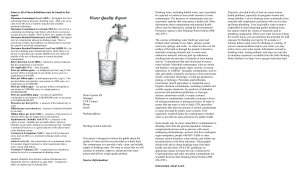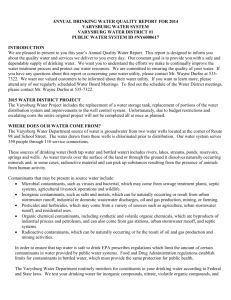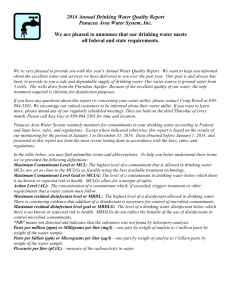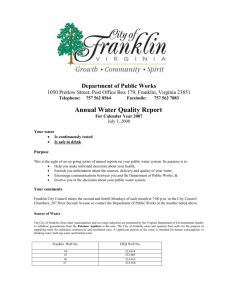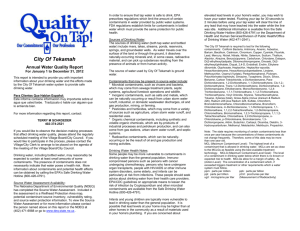Click here to the report.
advertisement
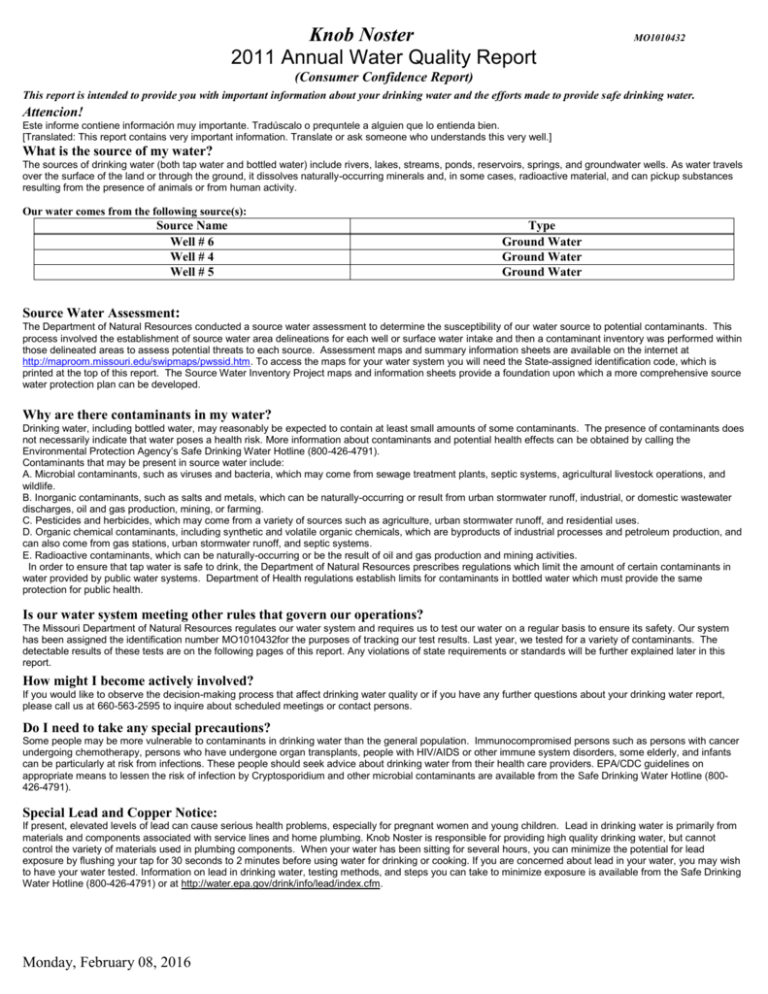
Knob Noster 2011 Annual Water Quality Report MO1010432 (Consumer Confidence Report) This report is intended to provide you with important information about your drinking water and the efforts made to provide safe drinking water. Attencion! Este informe contiene información muy importante. Tradúscalo o prequntele a alguien que lo entienda bien. [Translated: This report contains very important information. Translate or ask someone who understands this very well.] What is the source of my water? The sources of drinking water (both tap water and bottled water) include rivers, lakes, streams, ponds, reservoirs, springs, and groundwater wells. As water travels over the surface of the land or through the ground, it dissolves naturally-occurring minerals and, in some cases, radioactive material, and can pickup substances resulting from the presence of animals or from human activity. Our water comes from the following source(s): Source Name Well # 6 Well # 4 Well # 5 Type Ground Water Ground Water Ground Water Source Water Assessment: The Department of Natural Resources conducted a source water assessment to determine the susceptibility of our water source to potential contaminants. This process involved the establishment of source water area delineations for each well or surface water intake and then a contaminant inventory was performed within those delineated areas to assess potential threats to each source. Assessment maps and summary information sheets are available on the internet at http://maproom.missouri.edu/swipmaps/pwssid.htm. To access the maps for your water system you will need the State-assigned identification code, which is printed at the top of this report. The Source Water Inventory Project maps and information sheets provide a foundation upon which a more comprehensive source water protection plan can be developed. Why are there contaminants in my water? Drinking water, including bottled water, may reasonably be expected to contain at least small amounts of some contaminants. The presence of contaminants does not necessarily indicate that water poses a health risk. More information about contaminants and potential health effects can be obtained by calling the Environmental Protection Agency’s Safe Drinking Water Hotline (800-426-4791). Contaminants that may be present in source water include: A. Microbial contaminants, such as viruses and bacteria, which may come from sewage treatment plants, septic systems, agricultural livestock operations, and wildlife. B. Inorganic contaminants, such as salts and metals, which can be naturally-occurring or result from urban stormwater runoff, industrial, or domestic wastewater discharges, oil and gas production, mining, or farming. C. Pesticides and herbicides, which may come from a variety of sources such as agriculture, urban stormwater runoff, and residential uses. D. Organic chemical contaminants, including synthetic and volatile organic chemicals, which are byproducts of industrial processes and petroleum production, and can also come from gas stations, urban stormwater runoff, and septic systems. E. Radioactive contaminants, which can be naturally-occurring or be the result of oil and gas production and mining activities. In order to ensure that tap water is safe to drink, the Department of Natural Resources prescribes regulations which limit the amount of certain contaminants in water provided by public water systems. Department of Health regulations establish limits for contaminants in bottled water which must provide the same protection for public health. Is our water system meeting other rules that govern our operations? The Missouri Department of Natural Resources regulates our water system and requires us to test our water on a regular basis to ensure its safety. Our system has been assigned the identification number MO1010432for the purposes of tracking our test results. Last year, we tested for a variety of contaminants. The detectable results of these tests are on the following pages of this report. Any violations of state requirements or standards will be further explained later in this report. How might I become actively involved? If you would like to observe the decision-making process that affect drinking water quality or if you have any further questions about your drinking water report, please call us at 660-563-2595 to inquire about scheduled meetings or contact persons. Do I need to take any special precautions? Some people may be more vulnerable to contaminants in drinking water than the general population. Immunocompromised persons such as persons with cancer undergoing chemotherapy, persons who have undergone organ transplants, people with HIV/AIDS or other immune system disorders, some elderly, and infants can be particularly at risk from infections. These people should seek advice about drinking water from their health care providers. EPA/CDC guidelines on appropriate means to lessen the risk of infection by Cryptosporidium and other microbial contaminants are available from the Safe Drinking Water Hotline (800426-4791). Special Lead and Copper Notice: If present, elevated levels of lead can cause serious health problems, especially for pregnant women and young children. Lead in drinking water is primarily from materials and components associated with service lines and home plumbing. Knob Noster is responsible for providing high quality drinking water, but cannot control the variety of materials used in plumbing components. When your water has been sitting for several hours, you can minimize the potential for lead exposure by flushing your tap for 30 seconds to 2 minutes before using water for drinking or cooking. If you are concerned about lead in your water, you may wish to have your water tested. Information on lead in drinking water, testing methods, and steps you can take to minimize exposure is available from the Safe Drinking Water Hotline (800-426-4791) or at http://water.epa.gov/drink/info/lead/index.cfm. Monday, February 08, 2016 Knob Noster 2011 Annual Water Quality Report MO1010432 (Consumer Confidence Report) Contaminants Report Definitions: MCLG: Maximum Contaminant Level Goal, or the level of a contaminant in drinking water below which there is no known or expected risk to health. MCLGs allow for a margin of safety. MCL: Maximum Contaminant Level, or the highest level of a contaminant that is allowed in drinking water. MCLs are set as close to the MCLGs as feasible using the best available treatment technology. AL: Action Level, or the concentration of a contaminant which, when exceeded, triggers treatment or other requirements which a water system must follow.. TT: Treatment Technique, or a required process intended to reduce the level of a contaminant in drinking water. 90th percentile: For lead and Copper testing. 10% of test results are above this level and 90% are below this level. Level Found: is the average of all test results for a particular contaminant. Range of Detections: Shows the lowest and highest levels found during a testing period, if only one sample was taken, then this number equals the Level Found. MRLDG: Maximum Residual Disinfectant Level Goal, or the level of a drinking water disinfectant below which there is no known or expected risk to health. MRDL: Maximum Residual Disinfectant Level, or the highest level of a disinfectant allowed in drinking water. RAA: Running Annual Average, or the average of sample analytical results for samples taken during the previous four calendar quarters. Abbreviations: PPB: parts per billion or micrograms per liter. ppm: parts per million or milligrams per liter. n/a: not applicable. NTU: Nephelometric Turbidity Unit, used to measure cloudiness in drinking water. MFL: million fibers per liter, used to measure asbestos concentration. nd: not detectable at testing limits. The state has reduced monitoring requirements for certain contaminants to less often than once per year because the concentrations of these contaminants are not expected to vary significantly from year to year. Records with a sample year more than one year old are still considered representative. Regulated Contaminants Regulated Contaminants Collection Date Highest Value BARIUM 3/15/2011 0.0731 CHROMIUM FLUORIDE 3/15/2011 3/15/2011 1.52 0.76 Range Unit MCL MCLG Typical Source 0.0572 0.0731 1.02 - 1.52 0.45 - 0.76 ppm 2 2 ppb ppm 100 4 100 4 Discharge of drilling wastes; Discharge from metal refineries; Erosion of natural deposits Discharge from steel and pulp mills Natural deposits; Water additive which promotes strong teeth Unit MCL Monitoring RAA Range Period No Detected Results were Found in the Calendar Year of 2011 Disinfection Byproducts Lead and Copper COPPER LEAD Date 2008 - 2010 2008 - 2010 90TH Percentile 0.0966 2.8 Range Unit 0.00535 - 0.0997 1.93 - 3.18 ppm ppb Microbiological Result No Detected Results were Found in the Calendar Year of 2011 Radionuclides COMBINED RADIUM (-226 & -228) GROSS ALPHA PARTICLE ACTIVITY RADIUM-226 AL 1.3 15 MCLG Typical Source Sites Over AL 0 0 Typical Source Corrosion of household plumbing systems Corrosion of household plumbing systems MCL MCLG Collection Date Highest Value Range Unit MCL 2/28/2011 1.3 1.2 - 1.3 pCi/l 5 2/28/2011 4.7 3.6 - 4.7 pCi/l 2/28/2011 1.3 1.2 - 1.3 pCi/l MCLG Typical Source Typical Source Erosion of natural deposits Erosion of natural deposits 5 0 Violations and Health Effects Information During the 2011 calendar year, we had the below noted violation(s) of drinking water regulations. Type Category No Violations Occurred in the Calendar Year of 2011 Monday, February 08, 2016 Analyte Compliance Period Knob Noster 2011 Annual Water Quality Report MO1010432 (Consumer Confidence Report) Optional Monitoring (not required by EPA) Optional Contaminants Monitoring is not required for optional contaminants. Secondary Contaminants ALKALINITY, CACO3 STABILITY CALCIUM CHLORIDE HARDNESS, CARBONATE IRON MAGNESIUM MANGANESE PH POTASSIUM SODIUM SULFATE TDS ZINC Monday, February 08, 2016 Collection Date 3/15/2011 3/15/2011 3/15/2011 3/15/2011 3/15/2011 3/15/2011 3/15/2011 3/15/2011 3/15/2011 3/15/2011 3/15/2011 3/15/2011 3/15/2011 Highest Value 295 58.1 27 255 0.0678 26.7 0.00201 7.69 4.62 41.5 49.7 356 0.0268 Range Unit 288 - 295 52.6 - 58.1 21.7 - 27 231 - 255 0.0193 - 0.0678 24.3 - 26.7 0.00164 - 0.00201 7.64 - 7.69 3.3 - 4.62 22.4 - 41.5 38.8 - 49.7 324 - 356 0.00933 - 0.0268 MG/L MG/L MG/L MG/L MG/L MG/L MG/L PH MG/L MG/L MG/L MG/L MG/L MCL MCLG 250 0.3 0.05 8.5 20 250 500 5



